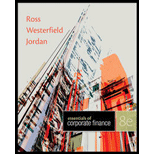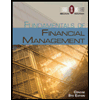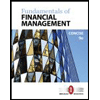
Essentials of Corporate Finance
8th Edition
ISBN: 9780078034756
Author: Stephen A. Ross, Randolph W. Westerfield, Bradford D. Jordan
Publisher: MCGRAW-HILL HIGHER EDUCATION
expand_more
expand_more
format_list_bulleted
Question
Chapter 10, Problem 25QP
Summary Introduction
To determine: The probability of getting double the value of an investment in one year.
Introduction:
The
Standard deviation refers to the variation in the actual observations from the average.
Z-Score helps to identify how many numbers of standard deviations the raw score or outcome is away from the average or mean.
Summary Introduction
To determine: The probability of getting triple the value of an investment in one year.
Expert Solution & Answer
Want to see the full answer?
Check out a sample textbook solution
Students have asked these similar questions
General Finance
Please don't answer i posted blurred image mistakely.
please comment below i will write values.
if you answer with incorrect values i will give unhelpful confirm.
no ai
Please don't answer i posted blurred image mistakely.
please comment below i will write values.
if you answer with incorrect values i will give unhelpful confirm.
Finan
Please don't answer i posted blurred image mistakely.
please comment below i will write values.
if you answer with incorrect values i will give unhelpful confirm.
Chapter 10 Solutions
Essentials of Corporate Finance
Ch. 10.1 - Prob. 10.1ACQCh. 10.1 - Why are unrealized capital gains or losses...Ch. 10.1 - What is the difference between a dollar return and...Ch. 10.2 - Prob. 10.2ACQCh. 10.2 - Prob. 10.2BCQCh. 10.2 - Prob. 10.2CCQCh. 10.2 - Prob. 10.2DCQCh. 10.2 - Prob. 10.2ECQCh. 10.2 - Prob. 10.2FCQCh. 10.3 - What do we mean by excess return and risk premium?
Ch. 10.3 - Prob. 10.3BCQCh. 10.3 - Prob. 10.3CCQCh. 10.3 - What is the first lesson from capital market...Ch. 10.4 - In words, how do we calculate a variance? A...Ch. 10.4 - Prob. 10.4BCQCh. 10.4 - Prob. 10.4CCQCh. 10.4 - What is the second lesson from capital market...Ch. 10.5 - Prob. 10.5ACQCh. 10.5 - Prob. 10.5BCQCh. 10.6 - What is an efficient market?Ch. 10.6 - Prob. 10.6BCQCh. 10 - Prob. 10.1CCh. 10 - Prob. 10.3CCh. 10 - Prob. 10.4CCh. 10 - Prob. 10.5CCh. 10 - Prob. 10.6CCh. 10 - Prob. 1CTCRCh. 10 - Prob. 2CTCRCh. 10 - Risk and Return. We have seen that over long...Ch. 10 - Market Efficiency Implications. Explain why a...Ch. 10 - Prob. 5CTCRCh. 10 - Prob. 6CTCRCh. 10 - Prob. 7CTCRCh. 10 - Prob. 8CTCRCh. 10 - Efficient Markets Hypothesis. There are several...Ch. 10 - Prob. 10CTCRCh. 10 - Prob. 1QPCh. 10 - Prob. 2QPCh. 10 - Prob. 3QPCh. 10 - Prob. 4QPCh. 10 - Prob. 5QPCh. 10 - Prob. 6QPCh. 10 - Prob. 7QPCh. 10 - Prob. 8QPCh. 10 - Prob. 9QPCh. 10 - Prob. 10QPCh. 10 - Prob. 11QPCh. 10 - Prob. 12QPCh. 10 - Prob. 13QPCh. 10 - Prob. 14QPCh. 10 - Prob. 15QPCh. 10 - Prob. 16QPCh. 10 - Prob. 17QPCh. 10 - Prob. 18QPCh. 10 - Prob. 19QPCh. 10 - Prob. 20QPCh. 10 - Prob. 21QPCh. 10 - Prob. 22QPCh. 10 - Prob. 23QPCh. 10 - Prob. 24QPCh. 10 - Prob. 25QPCh. 10 - Prob. 26QPCh. 10 - Prob. 27QPCh. 10 - Prob. 28QPCh. 10 - Prob. 1CCCh. 10 - Prob. 2CCCh. 10 - Prob. 3CCCh. 10 - Prob. 4CCCh. 10 - Prob. 5CC
Knowledge Booster
Similar questions
- see itPlease don't answer i posted blurred image mistakely. please comment below i will write values. if you answer with incorrect values i will give unhelpful confirm.arrow_forwardNo use ai. if image is blurr or data is not showing properly then dont answer i will sure deslike. please comment i will write values.arrow_forwardDon't use ai. if image is blurr or data is not showing properly then dont answer i will sure deslike. please comment i will write values.arrow_forward
- no ai Please don't answer i posted blurred image mistakely. please comment below i will write values. if you answer with incorrect values i will give unhelpful confirm.arrow_forwardFinance SubjPlease don't answer i posted blurred image mistakely. please comment below i will write values. if you answer with incorrect values i will give unhelpful confirm.arrow_forwardcalculate ratios for the financial statment given and show all working manually: 3. TIE Ratio 4. Cash Coverage Ratioarrow_forward
- calculate ratios for the financial statment given and show all working manually: 1. Debt Ratios 2. Debt to Equityarrow_forwardcalculate the following ratios for the statements and show all working: 1. Current Ratios 2. Quick Ratio 3. Cash Ratioarrow_forwardDont solve this question with incorrect values. i will give unhelpful . do not solvearrow_forward
arrow_back_ios
SEE MORE QUESTIONS
arrow_forward_ios
Recommended textbooks for you
 Intermediate Financial Management (MindTap Course...FinanceISBN:9781337395083Author:Eugene F. Brigham, Phillip R. DavesPublisher:Cengage LearningBusiness/Professional Ethics Directors/Executives...AccountingISBN:9781337485913Author:BROOKSPublisher:Cengage
Intermediate Financial Management (MindTap Course...FinanceISBN:9781337395083Author:Eugene F. Brigham, Phillip R. DavesPublisher:Cengage LearningBusiness/Professional Ethics Directors/Executives...AccountingISBN:9781337485913Author:BROOKSPublisher:Cengage Fundamentals Of Financial Management, Concise Edi...FinanceISBN:9781337902571Author:Eugene F. Brigham, Joel F. HoustonPublisher:Cengage Learning
Fundamentals Of Financial Management, Concise Edi...FinanceISBN:9781337902571Author:Eugene F. Brigham, Joel F. HoustonPublisher:Cengage Learning Fundamentals of Financial Management, Concise Edi...FinanceISBN:9781285065137Author:Eugene F. Brigham, Joel F. HoustonPublisher:Cengage Learning
Fundamentals of Financial Management, Concise Edi...FinanceISBN:9781285065137Author:Eugene F. Brigham, Joel F. HoustonPublisher:Cengage Learning Fundamentals of Financial Management, Concise Edi...FinanceISBN:9781305635937Author:Eugene F. Brigham, Joel F. HoustonPublisher:Cengage Learning
Fundamentals of Financial Management, Concise Edi...FinanceISBN:9781305635937Author:Eugene F. Brigham, Joel F. HoustonPublisher:Cengage Learning

Intermediate Financial Management (MindTap Course...
Finance
ISBN:9781337395083
Author:Eugene F. Brigham, Phillip R. Daves
Publisher:Cengage Learning


Business/Professional Ethics Directors/Executives...
Accounting
ISBN:9781337485913
Author:BROOKS
Publisher:Cengage

Fundamentals Of Financial Management, Concise Edi...
Finance
ISBN:9781337902571
Author:Eugene F. Brigham, Joel F. Houston
Publisher:Cengage Learning

Fundamentals of Financial Management, Concise Edi...
Finance
ISBN:9781285065137
Author:Eugene F. Brigham, Joel F. Houston
Publisher:Cengage Learning

Fundamentals of Financial Management, Concise Edi...
Finance
ISBN:9781305635937
Author:Eugene F. Brigham, Joel F. Houston
Publisher:Cengage Learning